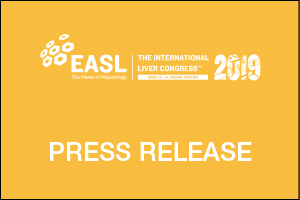
ILC 2019: Latest study suggests that integration of hepatitis B virus (HBV) DNA into the human genome is not restricted to the early phases of chronic HBV infection but also frequently occurs in individuals with hepatitis B e antigen (HBeAg)-negative chronic infection, a group of patients who are not considered treatment candidates.
13 April 2019, Vienna, Austria
EASL (EUROPEAN ASSOCIATION FOR THE STUDY OF THE LIVER)
A collaboration between scientists in Italy and the UK has yielded new evidence that integration of hepatitis B virus (HBV) DNA into the human genome is not restricted to the early phases of chronic HBV infection, but also occurs in individuals with hepatitis B e antigen (HBeAg)-negative infection, including those with low levels of HBV DNA who may not currently meet treatment criteria and are also defined as inactive carriers. This, say the investigators, could have important implications for the management of chronic HBV infection in the future.
Chronic HBV infection is a global threat to public health, and is associated with substantial liver-related morbidity and mortality.1 HBV infects and replicates in hepatocytes, where the viral DNA becomes integrated into the host cell genome, with onward transmission to progeny cells.1 The natural history of chronic HBV infection is divided into five phases: HBeAg-positive chronic infection, HBeAg-positive chronic hepatitis B, HBeAg-negative chronic HBV infection, HBeAg-negative chronic hepatitis B, and HBsAg-negative phase.2 Integration of HBV DNA has been shown to occur early in the course of HBV infection,3 producing a range of molecular changes that are thought to drive the development of hepatocellular carcinoma.4 Until now, however, little has been known about integration events in later phases of infection or in those considered to have quiescent disease.
To investigate this further, researchers from Italy and the UK studied samples of liver tissue from 40 HBeAg-negative individuals, whom they grouped according to their levels of viraemia: Group 1 had HBV DNA <2,000 IU/ml (n=8), Group 2 had HBV DNA 2,000–20,000 IU/ml (n=14), and Group 3 had HBV DNA >20,000 IU/ml (n=18). Integration events were analysed using next-generation sequencing technology.
According to Dr Romina Salpini from the University of Rome, Italy, who presented the study results today at The International Liver Congress™ 2019 in Vienna, Austria, integration events were detected in all three groups, with an overall prevalence of 35.4%: 25% in Group 1, 14.3% in Group 2, and 55.6% in Group 3. Among the 17 recognised integration events, 11 involved the region encoding HBx protein, which regulates the transcription and regulation of HBV,5 three involved the HBs antigen/polymerase(pol)-encoding region, and three involved the HBV core-encoding region.
‘We found that eleven out of 17 HBV integration events occurred preferentially within introns critical for RNA splicing and mRNA production,’ said Dr Salpini. ‘In six individuals, HBV integration localised in human genes regulating cell proliferation, and we know some of these genes are involved in hepatocarcinogenesis. We also found integration in genes that regulate lipid metabolism’, she noted.
What this study has demonstrated is that HBV integration occurs across all types of patients with HBeAg-negative disease, including those with a low level of HBV DNA (<2,000 IU/ml). The localization of the HBV integration also suggests that these events are not restricted to carcinogenesis and may also be involved in mechanisms regulating hepatocyte metabolism and antiviral immunity.
’Our findings underline the complexity of chronic hepatitis B and the evidence of HBV integration in low viraemic patients, who do not meet treatment criteria, is a timely reminder that these patients are also at risk of disease progression and the development of HCC,’ added Dr Salpini. ‘We believe these findings will have implications for the HBV cure program’.
###
About The International Liver Congress™
This annual congress is the biggest event in the EASL calendar, attracting scientific and medical experts from around the world to learn about the latest in liver research. Attending specialists present, share, debate and conclude on the latest science and research in hepatology, working to enhance the treatment and management of liver disease in clinical practice. This year, the congress is expected to attract approximately 10,000 delegates from all corners of the globe. The International Liver Congress™ 2019 will take place from 10–14 April 2019 at the Reed Messe Wien Congress and Exhibition Center, Vienna, Austria.
About The European Association for the Study of the Liver (EASL)
Since its foundation in 1966, this not-for-profit organization has grown to over 4,000 members from all over the world, including many of the leading hepatologists in Europe and beyond. EASL is the leading liver association in Europe, having evolved into a major European association with international influence, and with an impressive track record in promoting research in liver disease, supporting wider education and promoting changes in European liver policy.
Contact
For more information, please contact the ILC Press Office at:
- Email: press2@easloffice.eu
- Telephone: +44 (0)1444 811099
Onsite location reference
Session title: ‘General session 3’
Time, date and location of session: 11:30–11:45, 13 April 2019, Main plenary
Presenter: Romina Salpini, Italy
Abstract: The integration of hepatitis B virus into human genome is a common event in the setting of HBeAg negative disease: Implications for the treatment and management of CHB (GS-17)
Author disclosures
Romina Salpini has no relevant disclosures
References
- Seto WK, et al. Chronic hepatitis B virus infection. 2018;392(10161):2313–24.
- European Association for the Study of the Liver. EASL 2017 Clinical Practice Guidelines on the management of hepatitis B virus J Hepatol. 2017;67(2):370–98.
- Mason WS, et al. HBV DNA integration and clonal hepatocyte expansion in chronic hepatitis B patients considered immune tolerant. 2016;151(5):986-998.e4.
- Budzinska MA, et al. Sequence analysis of integrated hepatitis B virus DNA during HBeAg-seroconversion. Emerg Microbes Infect. 2018;7(1):142.
- Gong DY, et al. Role and functional domain of hepatitis B virus X protein in regulating HBV transcription and replication in vitro and in vivo. Viruses. 2013;5:1261–1271.
